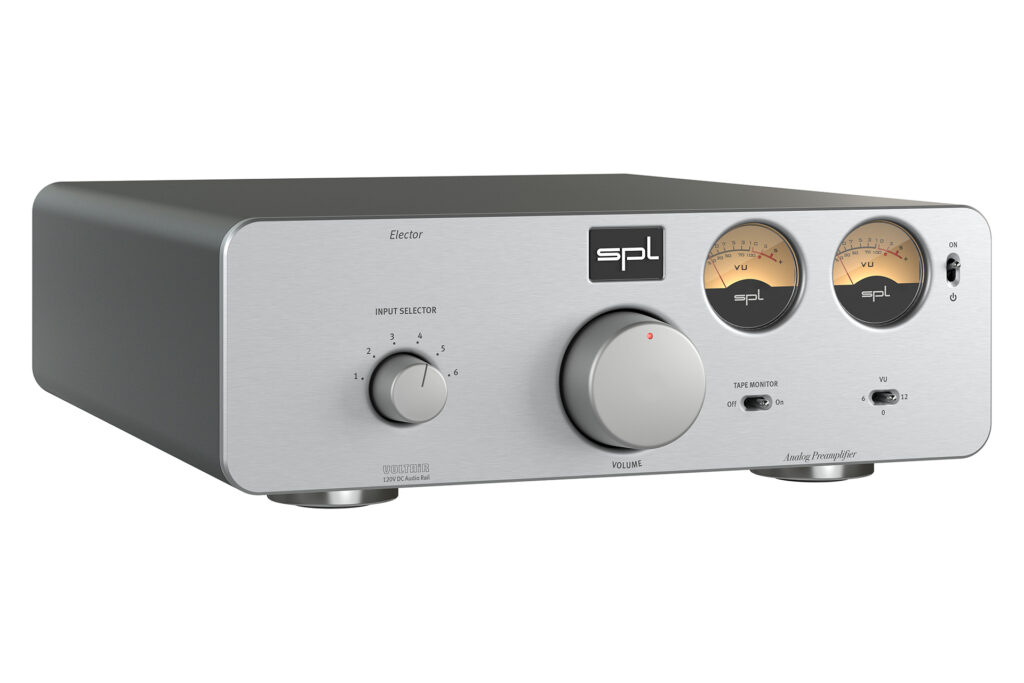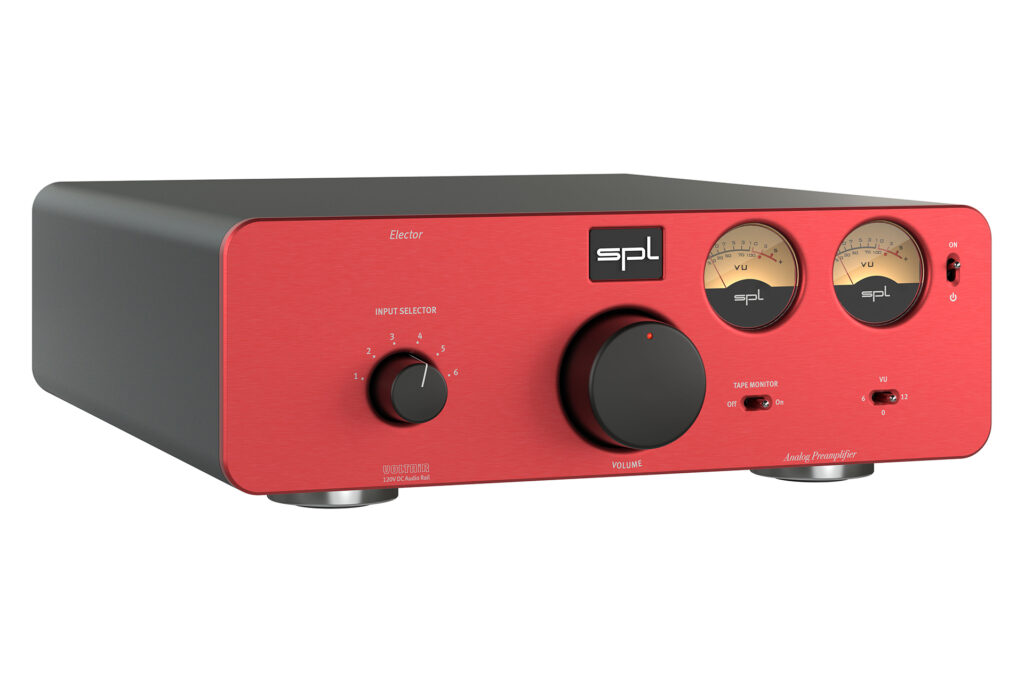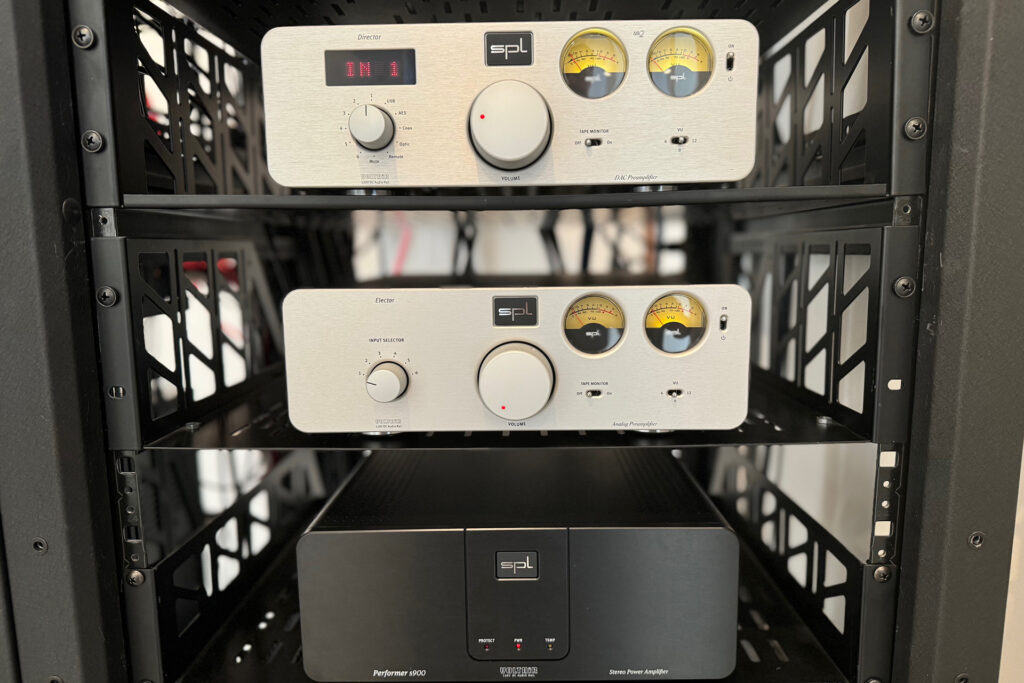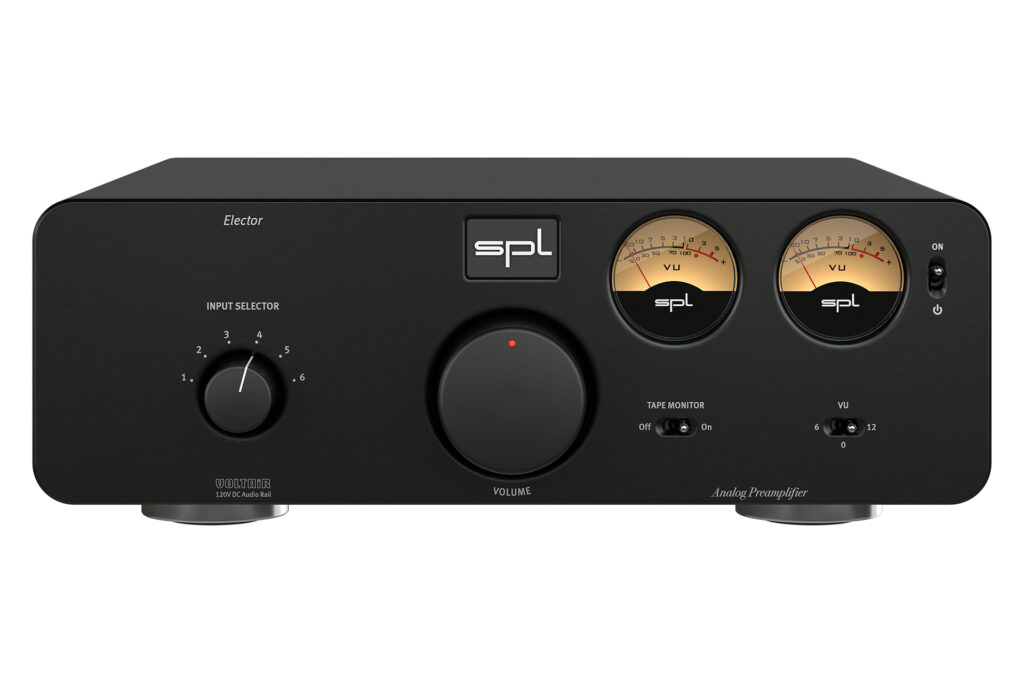By the time that this stereo preamp review goes live, you will likely have seen that its close relative, the SPL Director MK2 DAC Preamp for $3,699 (read the review), has won our 2024 Gear We Love Component of the Year. For about four grand and packing that level of performance, there were few products of the 104 (plus) that we evaluated in the calendar year 2024 that could hang with the SPL Director MK2 DAC preamp in terms of overall performance and total value. For those who don’t want to use that DAC inside of their stereo preamp, there is a simpler, more analog option from German pro audio company, which also happens to make some sweet audiophile gear, SPL. That product is the SPL Elector stereo preamp, priced at $2,699.
The SPL Elector is a simple analog stereo preamp, without any digital goodies like an internal DAC or room correction. Like the Director MK2, the SPL Elector comes in three metal finish colors, which is very unique. Where there isn’t any color is in the sound, as this preamp really, really, really doesn’t have “sound sound,” per se. There are some audiophiles who want their preamp to augment (often soften) the sound of their systems, but for those of us who are seeking to get as close to the master tape as possible, SPL brings some studio savvy to the audiophile experience. Exactly how good can a $2,699 stereo preamp sound? That’s what we are here to explore …

What Makes the SPL Elector Stereo Preamp So Special?
- Internally, the SPL Elector is the same audio preamp as the award-winning SPL Director MK2, just without the internal DAC. The SPL Elector just doesn’t have digital inputs or a sweet internal DAC, which is why it is about $1,000 less in price.
- The SPL Elector has a tape loop! When was the last time that you saw one of those in an audiophile preamp? With the rise in popularity of reel-to-reel machines, as well as vintage/collectable cassette tape decks, this isn’t as silly a feature as one might think.
- There are six total analog inputs. Three are balanced (XLR), and three are unbalanced (RCA). The switching on the front of the unit has a solid feel and beyond-simple operation.
- The SPL Elector’s performance sonically is attributed to a high-voltage DC technology called VOLTAiR. SPL isn’t the only company in Germany (or elsewhere) that uses design techniques built around internal high voltage. That’s part of what makes T+A’s power amps very good, too. VOLTAiR technology is at the core of SPL’s pro audio gear and provides a very resolute, very open but not colored whatsoever sonic performance. In the studio, this is a very sought-after sonic performance goal. A top-performing audiophile system should share that same sonic goal.
- The SPL Elector stereo preamp comes in black, silver or red. I’ve made the point for years that most every component in the audiophile and home theater space is basically a silver, white or black rectangle. It is true when you think about it. The SPL in red, as I tested it, looks killer as well as differentiated in my massive Middle Atlantic professional equipment rack.
- Gauges are super-cool on audiophile power amps, and it turns out that the same goes for preamps, as SPL has proven, as the Elector has some killer retro-tastic gauges right on the front faceplate. Now, don’t get all over me in the comments, as I am not suggesting that the gauges are a performance feature, as they are anything but that. They are audiophile window dressing that shows that SPL has a great design sense, as well as a bit of a sense of humor. That is a very welcome addition to the audiophile community.
- The build quality of the SPL Elector preamp is over-the-top good. The volume knob is milled, thick aluminum. The metal work is far better than any audiophile could ever expect from a preamp anywhere near this price range. The SPL Elector preamp feels significant in your hands, despite its small physical size.
- SPL can learn most infrared remotes with the push of the button. SPL doesn’t include a cheap but functional remote in the packaging to just check off another box in the implied audiophile customer wish list. Many audiophiles just don’t use a remote. Others use the volume control on their streamer.
- Home theater pass-through is an option. For those who smartly merge their audiophile system with their home theater sound system, the SPL Elector has a home theater pass-through that keeps both worlds dancing to the same records, which many audiophile preamps ignore. The SPL Elector has you covered.
Why Should You Care About the SPL Elector Stereo Preamp?
Normally, we pick a very narrow set of audiophiles who might want a specific product, but in the case of the SPL Elector, the enthusiast who will want to invest in such a product wants the sound (or lack of a house sound) that you get from a $6,000 to $10,000 audiophile preamp without spending the money. Under any normal circumstances, that “ask” is not only unrealistic but absurd. With the SPL Elector, an under-$3,000 stereo preamp can deliver on an outrageous standard such as sonically matching the performance of components costing 300 percent more at retail.

Some Things You Might Not Like About the SPL Elector Stereo Preamp
- The small width of the chassis makes rack-mounting a pain and possibly more expensive. The SPL Elector comes from the world of pro audio, thus it is likely that those products will go into a well-organized rack like the Middle Atlantic ones that I use. The non-standard sizing means that you need to buy a custom rack shelf and faceplate to make it look more polished or finished in your rack. With the amazingly reasonable price of the SPL Elector, this could be 15 to 20 percent more. Visually, non-17-inch-wide components don’t look as big, thus visually send the message that a bigger product might be better, when the size of the chassis has nothing to do with the sound in reality. I guess what I am asking for is a 17-inch-wide version of the unit when it is redesigned, as the SPL Elector is worthy of consideration versus any preamp at damn near any price.
- No remote included might offended some audiophiles. It shouldn’t, as this is a smart way that the German engineers have cost-engineered the SPL Elector to be a maximum value. I haven’t spent the money to make the SPL work on my Crestron remote, but I very well might. However, I make my normally modest adjustments to volume via BluOS or Roon, thus I don’t really need to change the volume too often, as I set it at unity gain and just leave it there. Others might want to control their volume differently, via other, non-digital sources like an audiophile turntable.
Listening to the SPL Elector Stereo Preamp …
The best audiophile preamps don’t add to the sound as much as they help present what is on the recording in a better, more revealing way. In my system, which is currently built around a BlueSound Node 2024 streamer (read the reviews from these links), a Bricasti M5 streamer/endpoint, a Bricasti M3 DAC, an Anthem STR preamp, a Pass Labs XA-25 Class-A power amp and Bowers & Wilkins 802 D4 loudspeakers, the SPL Elector stereo preamp delivered on this concept at levels that no reasonable audiophile could expect at sub-$3,000.
“Gold Dust Woman,” from the all-time audiophile classic album Rumours from Fleetwood Mac, via QoBuz, is a demo track that I’ve been using in my many 2024 digital to analog converter reviews. It is a great example of an analog recording that has space, detail and depth. With the SPL in the loop, I was simply floored by how open things sounded. Blankets were lifted from speakers, so to speak. The soundstage was well outside of the physical boundaries of the speakers, with lovely focus on center imaging. The twang of the guitars on this acoustic track were lively, but not sharp or harsh in any way. The flanger effect is subtle on this song, but it comes through in a compelling way with the SPL Elector in my rig. The entire listening experience was like hearing the song all over again, and I’ve heard this track hundreds upon hundreds of times. Simply put, other than the $10,000 Pass Labs XP-22 stereo preamp that I reviewed this past year, nothing has sonically taken me closer to the music or the recording. My mind is blown when I factor in the cost versus the level of sonic performance that you get for said money.
While the audiophile youth knows and loves their musical past, the SPL Elector demands to be given a more modern and bombastic test. This is when I cued up perhaps the most ambitious cover track recorded since Yoko had the balls to cover Imagine. “Voodoo Chile,” by Rage Against the Machine guitarist Tom Morello (AIFF – CD quality), is not just creatively a scary place that only the likes of, say, Van Halen or Jimi Hendrix himself would go, but the song is a sonic rocket ship of a track that had all of the detail and bombast that one needs to give his or her system a little wake-up call. Forget immaculately recorded yet obscure chamber music or Icelandic flugelhorn recordings from DAT tape, as we will leave our establishment print magazine writers or wonky audiophile show hotel room demos for that level of lame music. On this crushing cover of “Voodoo Chile,” the SPL Elector holds together sonically when Morello and the boys are throwing everything and the kitchen sink at them. Distorted, loud guitars – no problem. A big bass guitar sound? Also not an issue, as the bass was strong, loud and nicely proportional to the mix. At high volumes, the crashing cymbals were quite lively, but even as I was dodging paint chips flying off the wall from the sound that I was making, the SPL Elector delivered a coherent, high-energy musical experience that was nothing short of ear candy.
Going in a completely different direction and to a past era that never, ever gets old where I live, I cued up “Good Vibrations” from Disc Two of Good Vibrations: Thirty Years of the Beach Boys (AIFF – CD level ripped file). Did you watch the documentary about The Beach Boys on Apple TV? It was great and I learned a lot about the band that I didn’t know, specifically how their early history dovetailed with the British Invasion. I had no idea that McCartney and Lennon were such big Beach Boys fans, and that they basically broke into The Beach Boys’ London hotel room while they were out promoting the album Pet Sounds so that they could listen to the new record together. You need to watch this documentary if you like this genre of music at all, as it was fantastically done.
Sonically, the space between the lead vocals and the gently percussive organ sound to start the song shows off the openness that you get when putting the SPL into your system. It is addictively good-sounding, even if you are just hearing more of the recording. The use of a theremin on this song was groundbreaking in 1966 and foreshadowed the incredible recording and performance breakthroughs that would come to market from any number of the all-time best classic rock bands in the three years afterwards. The uniquely oscillating sound of this early, analog “synth” (for lack of a better word to describe a theremin) dances above the mix early in the track’s first few choruses. The vocal harmonies are well-layered and really tasty, considering that 1966 was still at the very end of the dark ages for modern recording.
Will the SPL Elector Stereo Preamp Hold Its Value?
SPL hasn’t had its coming-out party yet in the audiophile world, but they should, as their Class-AB amps are just as good as their preamps. At $2,699, the SPL Elector is a stunningly good value at retail price. How much more could this preamp drop in value? Not too far, because it competes with other audiophile preamps costing many times more money. If you are thinking of trying to pick up an SPL Elector preamp on the used market, don’t mess around if you see one at a good price. Just buy it, because it will be gone in the blink of an eye, as they are a fantastic value, as well as pretty rare on the used market.

What Is the Competition for the SPL Elector Preamp?
The Anthem STR Preamp at $4,000 (read the review) comes to mind, as I own one of these, as do my colleagues Mike Prager and Andrew Dewhirst. The Anthem STR Preamp is unbeatable in terms of its feature set and likely an even better comparison for the 2024 FutureAudiophile.com Gear We Love Component of the Year award winner, the SPL Director MK2 DAC/Preamp, which is closer in price as well as functionality. The Anthem’s ARC room correction gives it a super power that nearly every preamp not-named-NAD can’t compete with, but in a preamp-to-preamp comparison with volumes matched, the SPL is more resolute and open-sounding. I sent the SPL Director to Mike Prager, and he heard the same effect.
At $3,000, the AMPED AMERICA AAP-1 stereo preamp (read the review here) is a solid price and functionality match with the SPL Elector preamp. The AMPED AAP-1 isn’t the first product that would come to many audiophile minds, but Boris and his team have a very good thing going with this simple audiophile stereo preamp. The build quality of the AMPED AAP-1 is comparable to the SPL Elector, but the finishes, gauges and metal work set the SPL ahead of the AMPED AAP-1 on those fronts. Sonically, the AMPED AAP-1 is the best example in the price range for an open, transparent preamp that doesn’t have coloration or a house sound.
Here’s where we go to audiophile crazy land, as not since I had the Wayne Colburn-designed Pass Labs XP-22 stereo preamp (read my review) in my system that I have had this level of sonic refinement and true-to-the-master-level of resolution. The Pass Labs XP-22 is $10,000, and I planned on buying my review sample, but I spent my preamp money on a business-class ticket to the Munich HIFI Show. (I should have bought the preamp.) Do I still want an XP-22? Yes, sir, I do, but the SPL Elector is so close in performance, I will need to really buck up to get than next increment of performance.

Final Thoughts on the SPL Elector Stereo Preamp …
There is a fellow audiophile reviewer who I am friends with who deserves credit for finding an obscure German pro audio company making fantastically good and very reasonably-priced equipment. He owns a Pass Labs XP-22. He also owns an SPL Elector, as it is just that good in comparison, and at 70 percent less money. Look at what reviewers spend their money on if you want to know where the best values are. We can get anything in for review, but we can’t buy everything that comes into our rack. When we do, take note, because that gear is the really good stuff.
Did I buy the SPL? Of course I did. Does that mean that I am not getting a Pass Labs XP-22 someday? I will soon invest in the Pass Labs XP-22, as it is crazy good, but the value of the SPL Elector is worthy of people noting that I am sounding the audiophile alarm, because products this good at this price don’t present themselves all that often. Simply put, I don’t think you can find a preamp that sounds this resolute, detailed, open and true-to-the-source anywhere near the price. Will the SPL Elector win the Component of the Year award in 2025? Unlikely, as its DAC-wielding brother did that in 2024, but when I tell you that this preamp is a game-changer and a scary-good value, I am likely under-selling the value proposition of this affordable audiophile preamp. The SPL Elector preamp is a fast-track upgrade to the world of uber-high-end audio without any need to invest the big bucks to get there.




So, if I’m understanding this correctly, the Amped America pre-amp for 300 dollars more is a better sounding pre-amp than the SPL?